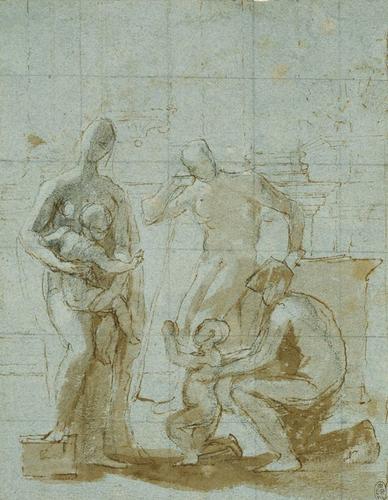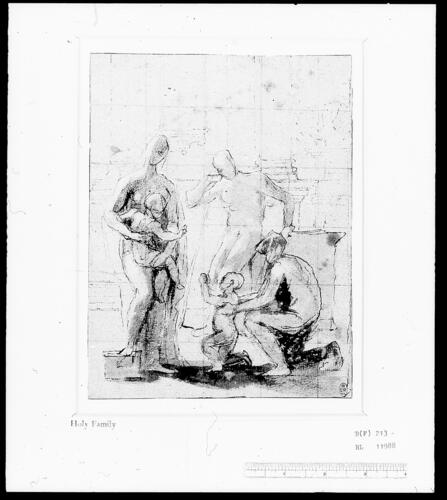The Holy Family in the Temple c.1641-3
Black chalk underdrawing, pen and brown ink, brown wash, on blue paper, squared in black chalk | 21.0 x 16.3 cm (sheet of paper) | RCIN 911988
-
A drawing of the Madonna and Child with St Joseph, the infant Baptist and his mother St Elizabeth, preparatory for a painting known in several versions, of which the finest is at Chantilly.
The drawing is squared for transfer and corresponds more or less with the disposition of the figures in the painting, but there are obvious differences between drawing and painting in the architectural background and in the portrayal of the figures here as nudes. The formulation of compositions with the figures unclothed was a commonplace of art theory, but Poussin (like many artists) only rarely followed such a procedure. The conception of the figures is strongly sculptural, with simplified limbs and one foot of the Madonna raised on a block, and reminiscent of Caravaggio's Madonna di Loreto (Sant'Agostino, Rome), suggesting that his range of interest in other artists' work extended beyond the obvious classicist prototypes.
A fragment of another drawing for the same composition is in the Los Angeles County Museum of Art (Rosenberg & Prat 1994, no. R560). The authorship of the painting and of both drawings has been questioned in recent years. The Massimi provenance of the present drawing is no guarantee of its authenticity, but the scale of the figures, their depiction in the nude and the degree of abstraction are comparable with certain drawings of the forties such as St Matthew and the angel (RCIN 911887 verso). The Los Angeles sketch, while not particularly attractive, is consistent in its handling of wash with drawings of the same period. And the sketches on RCIN 911920 verso are surely connected with the same composition, identical in scale, pen style, and the types of abstract, egg-headed, drop-shouldered Madonna and heavy, uncomfortably posed Child. Those sketches provide a point of reference for the dating of the project. As 911920 recto must have been executed around 1641, it is reasonable to suppose that Poussin was mulling over the composition during his years in Paris. But the painting is not mentioned in his many letters from that period, and it is thus unlikely (though not impossible) that any work was carried out then.
The painting now at Chantilly came from Palazzo Rospigliosi, and if it is the original it was probably commissioned from Poussin by Cardinal Giulio Rospigliosi, later Pope Clement IX. Rospigliosi had employed Poussin in the later 1630s, but he was absent from Rome between 1644 and 1653. It is therefore plausible that the composition was worked out sometime after 1641, and that the painting was executed between Poussin's return to Rome and the departure of Rospigliosi.Provenance
Cardinal Camillo Massimi (1620-1677); from whose heirs bought in 1739, for 300 scudi, by Richard Mead (1673-1754); probably presented to Frederick, Prince of Wales, by 1750.
-
Creator(s)
Acquirer(s)
-
Medium and techniques
Black chalk underdrawing, pen and brown ink, brown wash, on blue paper, squared in black chalk
Measurements
21.0 x 16.3 cm (sheet of paper)
Other number(s)
RL 11988Alternative title(s)
La Vergine, S. Elisabetta, e S. Gioseppe









